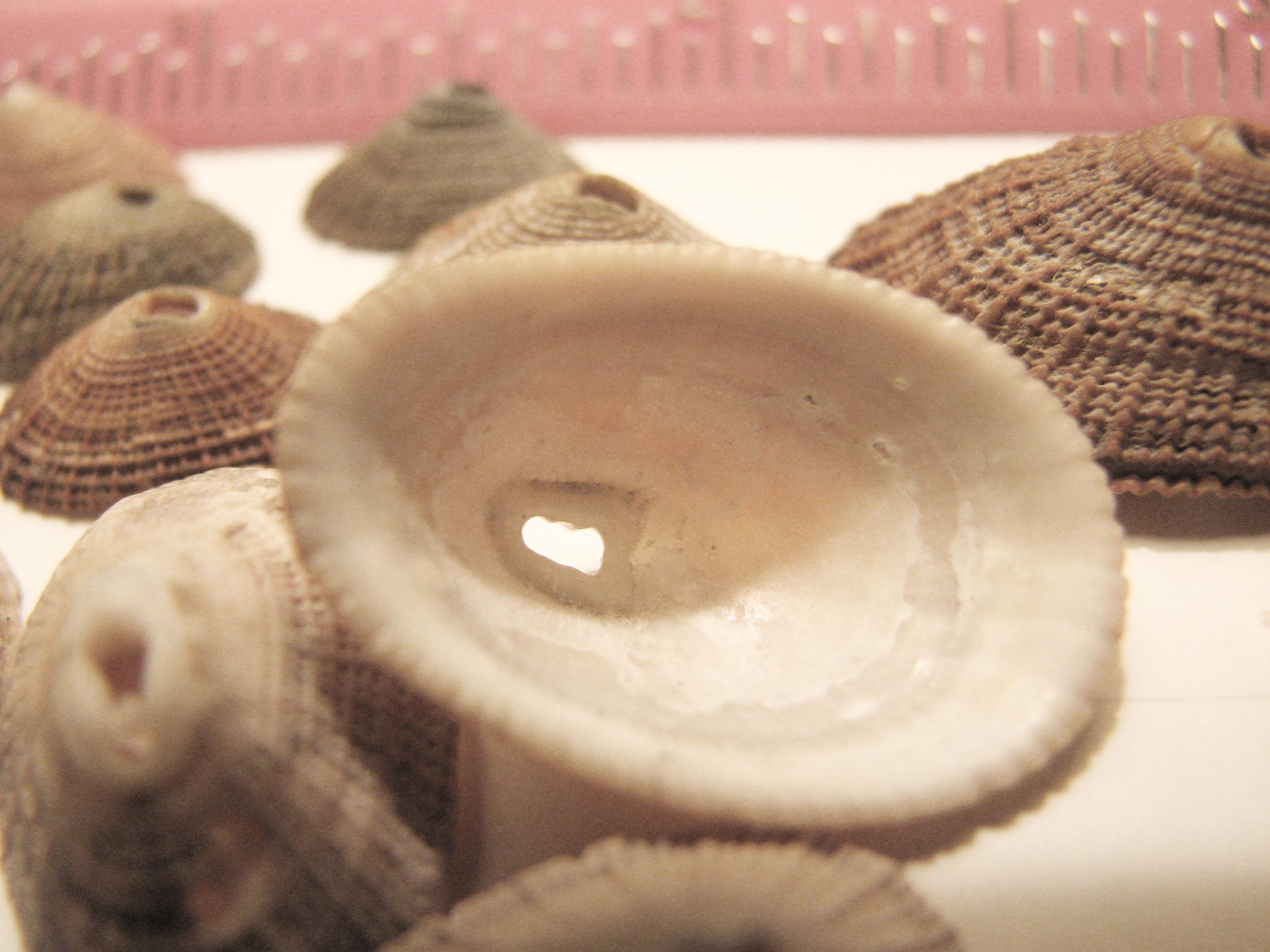- Keyhole limpet
Taxobox
name = Keyhole limpet

image_caption = "Diodora cayenensis "
regnum =Animal ia
phylum =Mollusca
classis =Gastropoda
superordo =Vetigastropoda
ordo =
superfamilia =Fissurelloidea
familia = Fissurellidae
familia_authority = Fleming, 1822
subdivision_ranks = Genera and species
subdivision = See text.The Keyhole limpet or klimpet is the
common name for thetaxonomic family Fissurellidae, a group oflimpet -like seasnail s, marinegastropod mollusc s in thesuperfamily Fissurelloidea .Distribution
Keyhole limpets live world-wide: in cold waters, warm waters, and in tropical waters.
Habitat
Fissurellids live on and under rocks, in the lower
intertidal zone s and also in deeper waters.hell description
Keyhole limpets somewhat resemble true limpets because of their simple conical shells, but in reality they are not closely related to true limpets, which are in the order
Patellogastropoda .For respiration,the shells of fissurellids have an apical perforation, marginal slit, notch, or internal groove. This allows a direct exit of exhalant water currents from the mantle cavity.
In addition keyhole limpets differ in several other ways both internally and externally from true limpets.
Genera (and some species) within the family Fissurellidae
* Genus "Buchanania" Lesson, 1830
* Genus "Cosmetalepas " Iredale, 1924
* Genus "Clypidina " Gray, 1847
* Genus "Dendrofissurella " Mclean and Kilburn, 1986
* Genus "Diodora " J. E. Gray, 1821
* Genus "Emarginella " Pilsbry, 1890
* Genus "Emarginula "Lamarck , 1801
** "Emarginula striatula " Quoy and Gaimard, 1834
* Genus "Fissurisepta " Seguenza, 1863
** "Fissurisepta festiva " Crozier, 1966
** "Fissurisepta manawatawhia " Powell, 1937
* Genus "Fissurella " Bruguière, 1789
* Genus "Hemitoma " Swainson, 1840
* Genus "Incisura" Hedley, 1904
** "Incisura lytteltonensis " E. A. Smith, 1894
* Genus "Laeviemarginula " Habe In Kuroda, 1953
* Genus "Laevinesta " Pilsbry and McGinty, 1952
* Genus "Leurolepas " J. H. McLean, 1970
* Genus "Lucapina " G. B. Sowerby II, 1835
* Genus "Lucapinella " Pilsbry, 1890
* Genus "Macrochisma " Sowerby, 1839
* Genus "Medusafissurella " Mclean and Kilburn, 1986
* Genus "Megatebennus " Pilsbry, 1890
* Genus "Megathura " Pilsbry, 1890
* Genus "Monodilepas " Finlay, 1927
** "Monodilepas diemenensis " Finlay, 1930
** "Monodilepas monilifera monilifera " (hutton, 1873)
** "Monodilepas monilifera carnleyensis " Powell, 1955
** "Monodilepas monilifera cookiana " Dell, 1953
** "Monodilepas otagoensis " Finlay, 1930
** "Monodilepas skinneri " Finlay, 1928
* Genus "Montfortula " Iredale, 1915
** "Montfortula rugosa " (Quoy and Gaimard, 1834)
* Genus "Montfortulana " Habe, 1961
* Genus "Nesta " H. Adams, 1870
* Genus "Notomella " Cotton, 1957
* Genus "Puncturella " R. T. Lowe, 1827
** "Puncturella analoga " Martens, 1903
** "Puncturella pseudanaloga " Powell, 1957
** "Puncturella demissa " Hedley, 1904
* Genus "Pupilaea " Gray In Sowerby, 1835
* Genus "Rimula " DeFrance, 1827
* Genus "Scelidotoma " Choe, Yoon and Habe, 1992
* Genus "Scutus " Montfort, 1810
** "Scutus breviculus " Blainville, 1817
* Genus "Tugali " Gray In Dieffenbach, 1843
** "Tugali colvillensis " Finlay, 1927
** "Tugali elegans " Gray, 1843
** "Tugali stewartiana " Powell, 1939
** "Tugali suteri suteri " (Thiele, 1916)
** "Tugali suteri sutherlandi " Fleming, 1948
* Genus "Vacerrena " Iredale, 1958
* Genus "Zeidora " A. Adams, 1860
** "Zeidora maoria " Powell, 1937References
* [http://shells.tricity.wsu.edu/ArcherdShellCollection/Gastropoda/Fissurellidae.html Fissurellidae (Keyhole Limpets)]
* [http://www.edwardtbabinski.us/beach_kids/sea_shells/keyhole_limpet/ Keyhole Limpet] and [http://www.ncseagrant.org/ NC Sea Grant]
* [http://zipcodezoo.com/Animals/D/Diodora_cayenensis.asp Cayenne Keyhole Limpet]
* [http://www.gastropods.com/3/Shell_15263.html Diodora cayenensis]
* [http://library.thinkquest.org/J002608/Keyhole.html Limpets]
* [http://www.mollusca.co.nz/checklist/checklist_frameset.htm Checklist of Mollusca]
* [http://www.nbi.noaa.gov/itis.aspx?tsn=566920 ITIS]
* Powell A. W. B., "New Zealand Mollusca", William Collins Publishers Ltd, Auckland, New Zealand1979 ISBN 0-00-216906-1
Wikimedia Foundation. 2010.
